Seven Suspension Technology
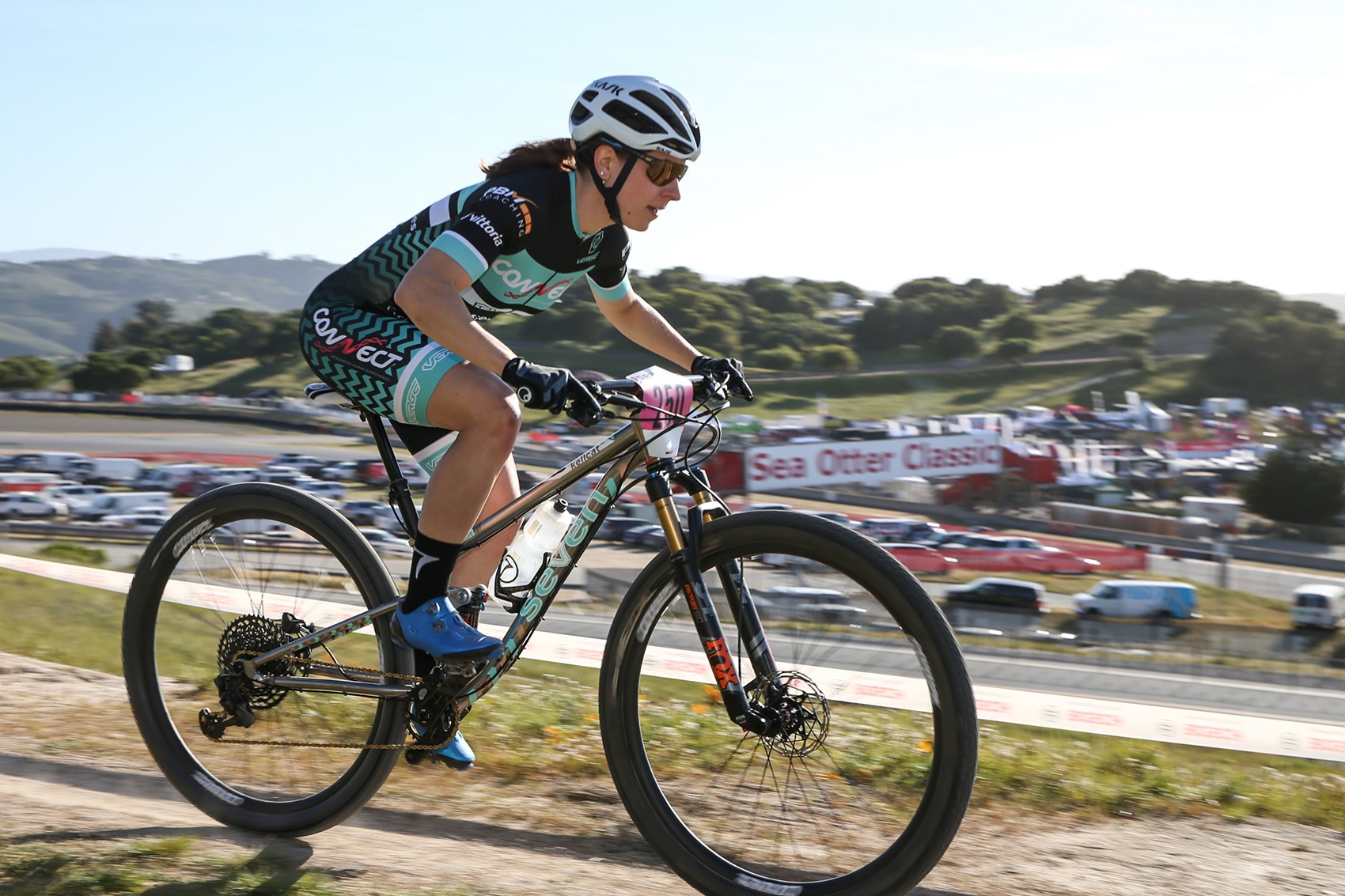
Balance Control System
Seven's Balance Control System (BCS) is the defining characteristic of all our suspension bikes. Show me the bikes!
Seven introduced its first dual suspension bike, the Pendere, more than 20 years ago. That bike incorporated a four-bar linkage, a feature we preserve in our latest dual suspension designs. Later we offered a progressive suspension bike line with models like the Duo and Duo-Lux. For those, we collaborated with Paul Turner, the founder of Rock Shox and Maverick. Our third generation suspension design project was a collaboration with phenom Dave Weagle. Trends and technologies have moved forward over the decades, but the basics of full-suspension bikes, the need to deliver a stable climbing platform coupled to a dynamic shock absorption system, remain the same.
Seven's Balance Control System suspension project takes everything we've learned in our 20-plus years and applies it in some new ways. Seven's BCS platform incorporates that proven, classic, workhorse four-bar linkage system with our ability to customize and tailor bikes in unique ways.
The result isn't one bike, but a platform for creating the perfect bike for your style of riding and personal preferences.
Mountain bike terminology has spiralled out of control over the last 5 years with new bikes spawning new categories that overlap with other new bikes in their own new categories.
What we have done with the BCS is both simplify and yet also hold open the door of possibilities in that way we do, offering modifications and variations that let you straddle categories, personalize your ride experience, and basically create your own category.
Here, is the simplicity part: For all BCS models we offer 27.5" and 29er wheel variations. You can optimize for race width tires or larger volume tires. Geometrically, you can blur the lines between categories. We can build for 1x or 2x drivetrains.
This is Seven bringing our manufacturing capabilities, specifically our methods for customizing, to a production suspension bike. This built-to-order process enables Seven to offer more versions and options than any other suspension system we've seen yet.
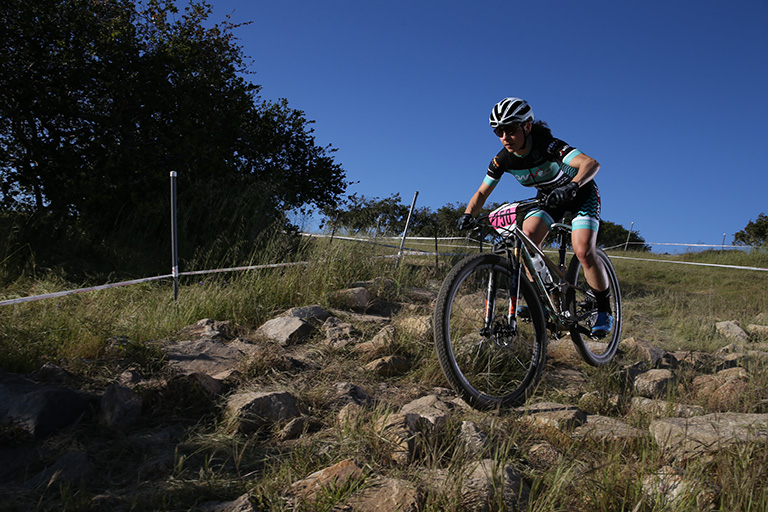
Fundamentals of Seven's Suspension System
For a dual suspension bike like Mobius, our first concern is the Instant Center of Rotation, also sometimes called the virtual pivot point when using a four-bar linkage. Where you place the IC affects anti-squat and brake jack (see explanations below). Essentially, that placement should keep the brake from compressing the shock and at the same time, limit the energy lost to suspension as the rider pedals. This is about creating a stable platform for the rider within a system under dynamic stress.
Anti-Squat is the bike's ability to resist pedal bob, to keep the rider's normal pedal stroke from activating the suspension. Anti-Rise is the bike's ability to resist brake jack or braking effect, to keep braking force from compressing the shock. These are oppositional forces, obviously. Complicating the picture is that the bike's anti-squat and anti-rise characteristics change based on drivetrain gear ratio.
Pedal Kickback, also called chain growth, is the process of the rear wheel's axle path moving away from the bottom bracket during shock compression, which increases the chain's length.
Progressiveness is the extent to which the suspension gets stiffer as it progresses through its travel. Mobius is neutrally progressive, which means it has excellent small bump sensitivity, i.e. fast micro-adjustments, and plush big hit absorption. Mobius doesn't over-correct. It reacts in small ways to smaller forces and in larger ways to larger forces.
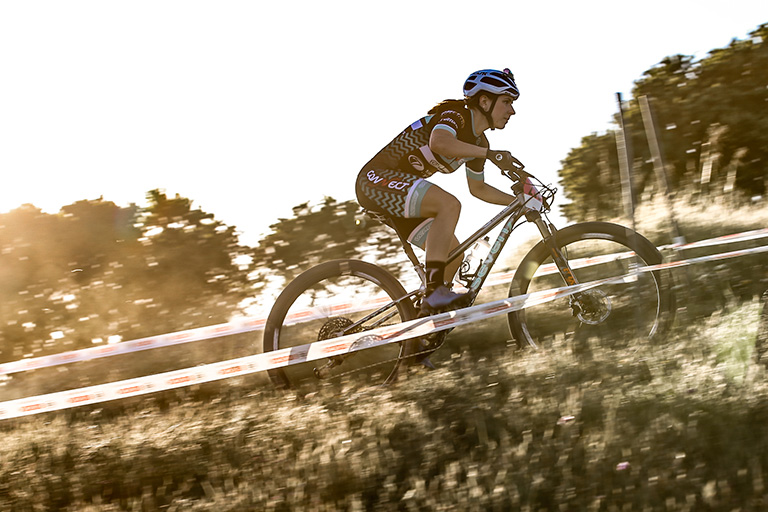
Elements of Design that Affect Seven's Suspension System
Many design considerations address the challenges that get our suspension to that place of perfect riding balance:
Suspension Specific Elements
- Four-bar linkage
- Kinematics
- The location of our four pivots
- Shock travel leverage ratio
- Chain force vector and chain tension
- Axle path
- Shock System
- Progressiveness
- Shock travel. Suspension travel: 100 or 120 mm
- Floating shock
- Trunnion mount design
- Shock type and settings
- High quality bearings (not bushings)
Non-Suspension Features
- Titanium front and rear
- Custom geometry
- Center of gravity
- Wheel size
- Contact patch location front and rear
- Solid aluminum block rockers
- Component choices
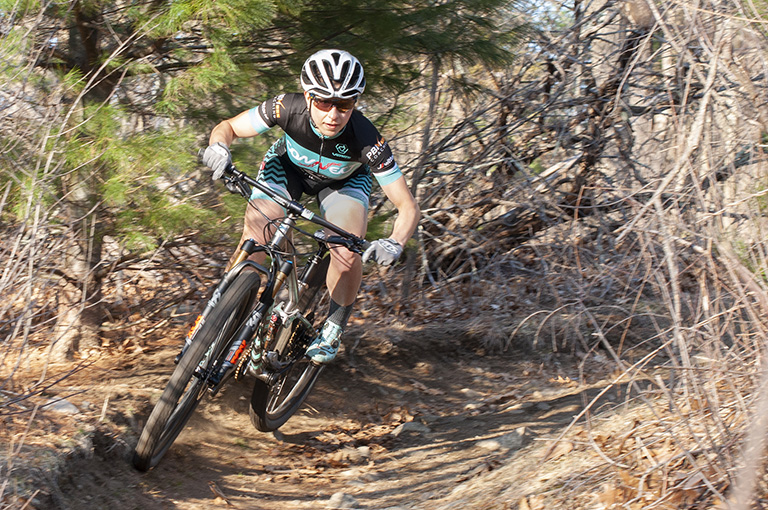
Seven's Suspension Bike Models
Cross Country Riding: Mobius SL 120 mm travel available with 29" or 27.5" wheels.
Pure Racing: Mobius SL 100 mm travel available with 29" or 27.5" wheels.
Seven's Instant Center Control
Generally, our first concern is the Instant Center of Rotation, also sometimes called the virtual pivot point when using a four-bar linkage. Where you place the IC affects anti-squat and brake jack. Essentially, that placement should keep the brake from compressing the shock and at the same time, limit the energy lost to suspension as the rider pedals. This is about creating a stable platform for the rider within a system under dynamic stress.
Seven has learned a lot over the last twenty years, working on three generations of suspension bikes. This fourth generation platform — the Balance Control System — is, by far, the most tuneable and customizable yet.
We spent a lot of time working through what we call the virtual pivot track of our suspension bike platform, basically the moving line of the rear wheel's pivot center. That moving line (VPT) is more useful than simple Instant Center, because the term "instant" simply means that we're describing one specific point along the virtual pivot track throughout the bike's travel. There are infinite instant centers as the suspension is engaged.
The rear wheel's center line of movement or VPT is one of the most important elements of a contemporary suspension bike. There's a pretty well-regarded range of IC placements that result in good suspension characteristics, but the ideal vector path varies depending on the bike's purpose, suspension travel, gearing, and more. Typically, IC and the resulting VPT are determined by a series of design compromises that should result in a stable, balanced ride.
How Do We Control VPT to Produce Optimal Suspension?
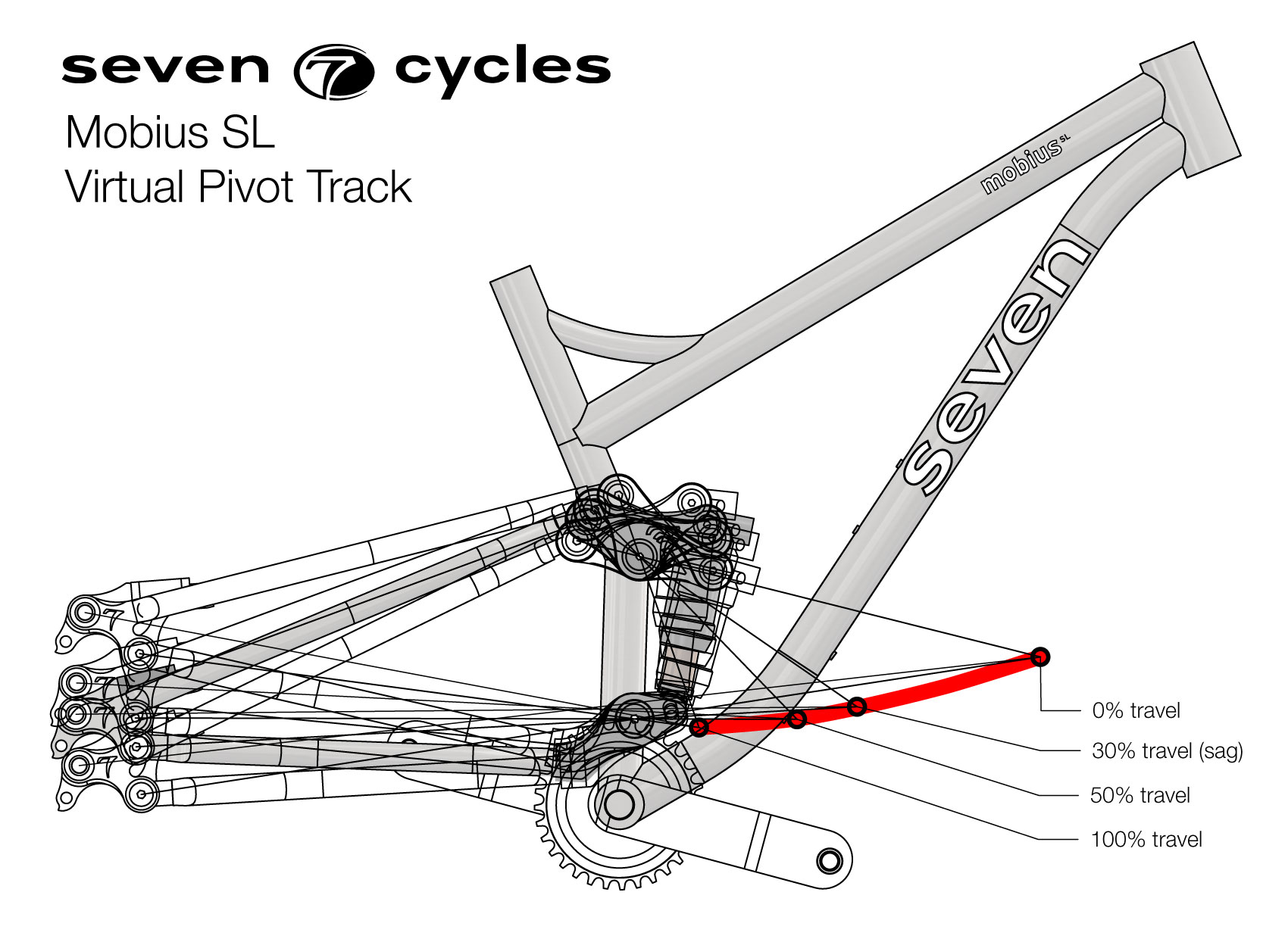
Seven has learned a lot over the last twenty years, working on three generations of suspension bikes. This fourth generation platform — the Balance Control System — is, by far, the most tuneable and customizable yet.
We have five basic ways to control each custom bike's virtual pivot track (VPT). Some are obvious and common. Some are unusual. As with so many aspects of suspension design, the important factors are all interrelated and tricky to isolate. Altering one affects the others.
We spent a lot of time working through what we call the virtual pivot track of our suspension bike platform, basically the moving line of the rear wheel's pivot center. That moving line (VPT) is more useful than simple Instant Center, because the term "instant" simply means that we're describing one specific point along the virtual pivot track throughout the bike's travel. There are infinite instant centers as the suspension is engaged.
The rear wheel's center line of movement or VPT is one of the most important elements of a contemporary suspension bike. There's a pretty well-regarded range of IC placements that result in good suspension characteristics, but the ideal vector path varies depending on the bike's purpose, suspension travel, gearing, and more. Typically, IC and the resulting VPT are determined by a series of design compromises that should result in a stable, balanced ride.
How Do We Control VPT to Produce Optimal Suspension?
We have five basic ways to control each custom bike's virtual pivot track (VPT). Some are obvious and common. Some are unusual. As with so many aspects of suspension design, the important factors are all interrelated and tricky to isolate. Altering one affects the others.
Here's how it works:
- Seven's suspension platform starts with a four-bar linkage. By having four tuneable pivot points, we can dictate the virtual pivot track precisely. This controlled movement allows us to optimize and tightly manage much of the suspension's behavior.
-
Probably even more important than the pivot location method is Seven's core customization. Forget about custom in terms of fit and tubeset tailoring — of course, we offer those with our suspension bikes. With our suspension series, we're also talking about the rider's center of gravity, tire contact patch location (both front and rear), gear ratios, suspension travel, and more.
Seven's customization process for suspension design is simple and easy for the rider to participate in. Certain characteristics Seven defines; certain performance characteristics the rider gets to define. Don't worry. You define the stuff you probably want to anyway: preferred wheel size, gearing, ride style, some level of front and rear shock travel, and more.
Seven defines the virtual pivot track, the rider's center of mass, the squat and anti-squat characteristics, brake force management, and suspension travel progressiveness among other things. Together we create a bike that rides like no other, and we argue that, by definition, rides better because it's designed specifically for you.
- The biggest element we tune trough customization is the center of gravity, COG, or center of mass. The more accurately we can place the rider in space, the more control the rider has, and the better the bike handles. This is critical for suspension performance in part because the rider's COG shifts significantly during trail riding — both fore-aft and up and down — and because the rider weighs so much more than the bike. Accelerating makes the rear suspension want to squat because the center of mass shifts backward, and a lot more than it feels. Descending moves the COG forward significantly and unweights the rear end at the wrong times. A 10% change in location of COG between the wheels, or about 4 inches, completely alters the suspension's performance. Tuning the frame geometry to manage this constant shift is helpful.
- Another important way Seven improves suspension performance is by accounting for the rider's chain force vector (CFV) or chain path. A few years ago this kind of tuning wasn't particularly helpful because cranksets were doubles or triples, and the cassette range was about 270%. Now cassette range is often nearly 500%, and there's usually one ring in the front. These produce very different CFVs than five years ago. This means optimizing the rear wheel's virtual pivot track is very different, too. Seven can optimize the suspension geometry as drive systems evolve.
- Seven even controls tire contact patch locations for both wheels. This may seem trivial, but the contact patch is the starting point for optimizing squat-anti-squat, pedaling feedback, center of gravity, and more. Patch locations are determined by almost every element of front and rear end frame geometry along with wheel size. Seven can obviously tune and optimize each of these ingredients for any given riding style and suspension characteristic.
Individually, no one factor above makes a massive difference to the suspension character of the bike. That's why stock bikes can get away with being non-optimal for a given rider. But, stack all of these together and you get a finely-tuned, optimized bike that will make a difference on the trail. That's what makes BCS, and the bikes built around it, something really unique and not yet offered in the market.
